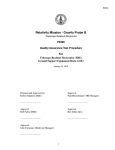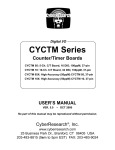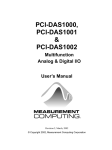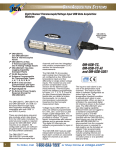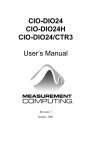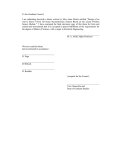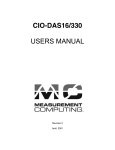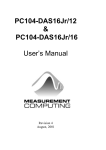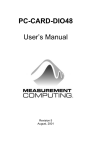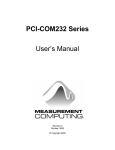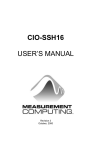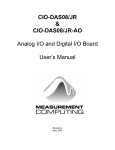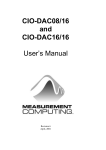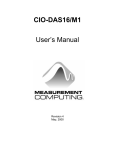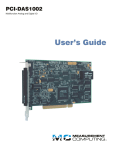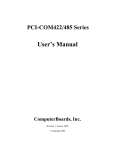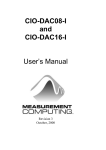Download Artisan Technology Group is your source for quality new and
Transcript
Artisan Technology Group is your source for quality new and certified-used/pre-owned equipment • FAST SHIPPING AND DELIVERY • TENS OF THOUSANDS OF IN-STOCK ITEMS • EQUIPMENT DEMOS • HUNDREDS OF MANUFACTURERS SUPPORTED • LEASING/MONTHLY RENTALS • ITAR CERTIFIED SECURE ASSET SOLUTIONS SERVICE CENTER REPAIRS Experienced engineers and technicians on staff at our full-service, in-house repair center WE BUY USED EQUIPMENT Sell your excess, underutilized, and idle used equipment We also offer credit for buy-backs and trade-ins www.artisantg.com/WeBuyEquipment InstraView REMOTE INSPECTION LOOKING FOR MORE INFORMATION? Visit us on the web at www.artisantg.com for more information on price quotations, drivers, technical specifications, manuals, and documentation SM Remotely inspect equipment before purchasing with our interactive website at www.instraview.com Contact us: (888) 88-SOURCE | [email protected] | www.artisantg.com CIO-DAS1401/12, CIO-DAS1402/12, CIO-DAS1402/16 Data Acquisition & Control Boards User’s Manual Revision 7 November, 2000 Artisan Technology Group - Quality Instrumentation ... Guaranteed | (888) 88-SOURCE | www.artisantg.com LIFETIME WARRANTY Every hardware product manufactured by Measurement Computing Corp. is warranted against defects in materials or workmanship for the life of the product, to the original purchaser. Any products found to be defective will be repaired or replaced promptly. LIFETIME HARSH ENVIRONMENT WARRANTYTM Any Measurement Computing Corp. product which is damaged due to misuse may be replaced for only 50% of the current price. I/O boards face some harsh environments, some harsher than the boards are designed to withstand. When that happens, just return the board with an order for its replacement at only 50% of the list price. Measurement Computing Corp. does not need to profit from your misfortune. By the way, we will honor this warranty for any other manufacture’s board that we have a replacement for! 30 DAY MONEY-BACK GUARANTEE Any Measurement Computing Corp. product may be returned within 30 days of purchase for a full refund of the price paid for the product being returned. If you are not satisfied, or chose the wrong product by mistake, you do not have to keep it. Please call for a RMA number first. No credits or returns accepted without a copy of the original invoice. Some software products are subject to a repackaging fee. These warranties are in lieu of all other warranties, expressed or implied, including any implied warranty of merchantability or fitness for a particular application. The remedies provided herein are the buyer’s sole and exclusive remedies. Neither Measurement Computing Corp., nor its employees shall be liable for any direct or indirect, special, incidental or consequential damage arising from the use of its products, even if Measurement Computing Corp. has been notified in advance of the possibility of such damages. MEGA-FIFO, the CIO prefix to data acquisition board model numbers, the PCM prefix to data acquisition board model numbers, PCM-DAS08, PCM-D24C3, PCM-DAC02, PCM-COM422, PCM-COM485, PCM-DMM, PCM-DAS16D/12, PCM-DAS16S/12, PCM-DAS16D/16, PCM-DAS16S/16, PCI-DAS6402/16, Universal Library, InstaCal, Harsh Environment Warranty and Measurement Computing Corp. are registered trademarks of Measurement Computing Corp. IBM, PC, and PC/AT are trademarks of International Business Machines Corp. Windows is a trademark of Microsoft Corp. All other trademarks are the property of their respective owners. Information furnished by Measurement Computing Corp. is believed to be accurate and reliable. However, no responsibility is assumed by Measurement Computing Corp. neither for its use; nor for any infringements of patents or other rights of third parties, which may result from its use. No license is granted by implication or otherwise under any patent or copyrights of Measurement Computing Corp. All rights reserved. No part of this publication may be reproduced, stored in a retrieval system, or transmitted, in any form by any means, electronic, mechanical, by photocopying, recording or otherwise without the prior written permission of Measurement Computing Corp. Notice Measurement Computing Corp. does not authorize any Measurement Computing Corp. product for use in life support systems and/or devices without the written approval of the President of Measurement Computing Corp. Life support devices/systems are devices or systems which, a) are intended for surgical implantation into the body, or b) support or sustain life and whose failure to perform can be reasonably expected to result in injury. Measurement Computing Corp. products are not designed with the components required, and are not subject to the testing required to ensure a level of reliability suitable for the treatment and diagnosis of people. © Copyright 2000, Measurement Computing Corporation HM CIO-DAS140#_1#.lwp Artisan Technology Group - Quality Instrumentation ... Guaranteed | (888) 88-SOURCE | www.artisantg.com Table of Contents 1 INTRODUCTION . . . . . . . . . . . . . . . . . . . . . . . . . . . . . . . . . . . . . . . . . . . . . . . . . . . . . . . . . . . . . . . . . . . . . . . . . . 1 2 SOFTWARE INSTALLATION . . . . . . . . . . . . . . . . . . . . . . . . . . . . . . . . . . . . . . . . . . . . . . . . . . . . . . . . . . . . . . 1 3 HARDWARE INSTALLATION . . . . . . . . . . . . . . . . . . . . . . . . . . . . . . . . . . . . . . . . . . . . . . . . . . . . . . . . . . . . . . 1 3.1 BASE ADDRESS SWITCHES . . . . . . . . . . . . . . . . . . . . . . . . . . . . . . . . . . . . . . . . . . . . . . . . . . . . . . . . . . . . 1 3.2 DMA LEVEL SELECT . . . . . . . . . . . . . . . . . . . . . . . . . . . . . . . . . . . . . . . . . . . . . . . . . . . . . . . . . . . . . . . . . . 2 3.3 1/10 MHz XTAL JUMPER . . . . . . . . . . . . . . . . . . . . . . . . . . . . . . . . . . . . . . . . . . . . . . . . . . . . . . . . . . . . . . . 2 3.4 8/16 CHANNEL SELECT . . . . . . . . . . . . . . . . . . . . . . . . . . . . . . . . . . . . . . . . . . . . . . . . . . . . . . . . . . . . . . . . 2 3.5 BIPOLAR/UNIPOLAR MODE SELECTION . . . . . . . . . . . . . . . . . . . . . . . . . . . . . . . . . . . . . . . . . . . . . . . . 2 3.6 PACER EDGE SELECT . . . . . . . . . . . . . . . . . . . . . . . . . . . . . . . . . . . . . . . . . . . . . . . . . . . . . . . . . . . . . . . . . 3 3.7 AUXILIARY TRIGGER . . . . . . . . . . . . . . . . . . . . . . . . . . . . . . . . . . . . . . . . . . . . . . . . . . . . . . . . . . . . . . . . . 3 3.8 BURST MODE GENERATOR . . . . . . . . . . . . . . . . . . . . . . . . . . . . . . . . . . . . . . . . . . . . . . . . . . . . . . . . . . . . 3 4 CONNECTOR PINOUTS . . . . . . . . . . . . . . . . . . . . . . . . . . . . . . . . . . . . . . . . . . . . . . . . . . . . . . . . . . . . . . . . . . . 4 5 ANALOG CONNECTIONS . . . . . . . . . . . . . . . . . . . . . . . . . . . . . . . . . . . . . . . . . . . . . . . . . . . . . . . . . . . . . . . . . 5 5.1 ANALOG INPUTS . . . . . . . . . . . . . . . . . . . . . . . . . . . . . . . . . . . . . . . . . . . . . . . . . . . . . . . . . . . . . . . . . . . . . 5 5.1.1 Single-Ended Inputs . . . . . . . . . . . . . . . . . . . . . . . . . . . . . . . . . . . . . . . . . . . . . . . . . . . . . . . . . . . . . . . . 5 5.1.2 Differential Inputs . . . . . . . . . . . . . . . . . . . . . . . . . . . . . . . . . . . . . . . . . . . . . . . . . . . . . . . . . . . . . . . . . . 5 5.2 SYSTEM GROUNDS and ISOLATION . . . . . . . . . . . . . . . . . . . . . . . . . . . . . . . . . . . . . . . . . . . . . . . . . . . . 7 5.2.1 Ground Testing . . . . . . . . . . . . . . . . . . . . . . . . . . . . . . . . . . . . . . . . . . . . . . . . . . . . . . . . . . . . . . . . . . . . 7 5.2.2 Systems with Common Grounds . . . . . . . . . . . . . . . . . . . . . . . . . . . . . . . . . . . . . . . . . . . . . . . . . . . . . . . 7 5.3 WIRING CONFIGURATIONS . . . . . . . . . . . . . . . . . . . . . . . . . . . . . . . . . . . . . . . . . . . . . . . . . . . . . . . . . . . . 8 5.3.1 Common Ground / Single-Ended Inputs . . . . . . . . . . . . . . . . . . . . . . . . . . . . . . . . . . . . . . . . . . . . . . . . . 8 5.3.2 Common Ground / Differential Inputs . . . . . . . . . . . . . . . . . . . . . . . . . . . . . . . . . . . . . . . . . . . . . . . . . . 9 5.3.3 Common Mode Voltage Less Than +/-10V / Single-Ended Inputs . . . . . . . . . . . . . . . . . . . . . . . . . . . . 9 5.3.4 Common Mode Voltage, Less than +/-10V / Differential Inputs . . . . . . . . . . . . . . . . . . . . . . . . . . . . . 9 5.3.5 Common Mode Voltage, Greater Than +/-10V . . . . . . . . . . . . . . . . . . . . . . . . . . . . . . . . . . . . . . . . . 10 5.3.6 Isolated Grounds / Single-Ended Inputs . . . . . . . . . . . . . . . . . . . . . . . . . . . . . . . . . . . . . . . . . . . . . . . . 11 5.3.7 Isolated Grounds / Differential Inputs . . . . . . . . . . . . . . . . . . . . . . . . . . . . . . . . . . . . . . . . . . . . . . . . . 11 6 REGISTER ARCHITECTURE . . . . . . . . . . . . . . . . . . . . . . . . . . . . . . . . . . . . . . . . . . . . . . . . . . . . . . . . . . . . . . 12 6.1 INTRODUCTION . . . . . . . . . . . . . . . . . . . . . . . . . . . . . . . . . . . . . . . . . . . . . . . . . . . . . . . . . . . . . . . . . . . . . 12 6.2 CONTROL & DATA REGISTERS . . . . . . . . . . . . . . . . . . . . . . . . . . . . . . . . . . . . . . . . . . . . . . . . . . . . . . . 12 6.2.1 A/D Data & Channel Registers (CIO-DAS140#/12 . . . . . . . . . . . . . . . . . . . . . . . . . . . . . . . . . . . . . . . 13 6.2.2 A/D Data & Channel Registers (CIO-DAS1402/16) . . . . . . . . . . . . . . . . . . . . . . . . . . . . . . . . . . . . . . 14 6.2.3 Channel MUX Scan Limits Register . . . . . . . . . . . . . . . . . . . . . . . . . . . . . . . . . . . . . . . . . . . . . . . . . . . 14 6.2.4 Four-Bit Digital I/O Registers . . . . . . . . . . . . . . . . . . . . . . . . . . . . . . . . . . . . . . . . . . . . . . . . . . . . . . . 14 6.2.5 Status Registers . . . . . . . . . . . . . . . . . . . . . . . . . . . . . . . . . . . . . . . . . . . . . . . . . . . . . . . . . . . . . . . . . . . 15 6.2.6 DMA, Interrupt & Trigger Control . . . . . . . . . . . . . . . . . . . . . . . . . . . . . . . . . . . . . . . . . . . . . . . . . . . . 15 6.2.7 Pacer Clock Control Register . . . . . . . . . . . . . . . . . . . . . . . . . . . . . . . . . . . . . . . . . . . . . . . . . . . . . . . . 16 6.2.8 Programmable Gain Control Register / Burst Rate . . . . . . . . . . . . . . . . . . . . . . . . . . . . . . . . . . . . . . . 17 6.2.9 Pacer Clock Data & Control Registers . . . . . . . . . . . . . . . . . . . . . . . . . . . . . . . . . . . . . . . . . . . . . . . . 18 6.2.10 Convert Disable Register . . . . . . . . . . . . . . . . . . . . . . . . . . . . . . . . . . . . . . . . . . . . . . . . . . . . . . . . . . 18 6.2.11 Burst Mode Enable Register . . . . . . . . . . . . . . . . . . . . . . . . . . . . . . . . . . . . . . . . . . . . . . . . . . . . . . . . 18 6.2.12 DAS1400 Mode Enable Register . . . . . . . . . . . . . . . . . . . . . . . . . . . . . . . . . . . . . . . . . . . . . . . . . . . . 19 6.2.13 Burst Status Register . . . . . . . . . . . . . . . . . . . . . . . . . . . . . . . . . . . . . . . . . . . . . . . . . . . . . . . . . . . . . . 19 7 CALIBRATION AND TEST . . . . . . . . . . . . . . . . . . . . . . . . . . . . . . . . . . . . . . . . . . . . . . . . . . . . . . . . . . . . . . . . 19 7.1 REQUIRED EQUIPMENT . . . . . . . . . . . . . . . . . . . . . . . . . . . . . . . . . . . . . . . . . . . . . . . . . . . . . . . . . . . . . . 19 7.2 CALIBRATING THE A/D CONVERTERS . . . . . . . . . . . . . . . . . . . . . . . . . . . . . . . . . . . . . . . . . . . . . . . . . 19 8 ANALOG ELECTRONICS . . . . . . . . . . . . . . . . . . . . . . . . . . . . . . . . . . . . . . . . . . . . . . . . . . . . . . . . . . . . . . . . . 20 8.1 VOLTAGE DIVIDERS . . . . . . . . . . . . . . . . . . . . . . . . . . . . . . . . . . . . . . . . . . . . . . . . . . . . . . . . . . . . . . . . . 20 8.2 LOW-PASS FILTERS . . . . . . . . . . . . . . . . . . . . . . . . . . . . . . . . . . . . . . . . . . . . . . . . . . . . . . . . . . . . . . . . . . 21 9 SPECIFICATIONS . . . . . . . . . . . . . . . . . . . . . . . . . . . . . . . . . . . . . . . . . . . . . . . . . . . . . . . . . . . . . . . . . . . . . . . . 22 9.1 CIO-DAS1401/12 and CIO-DAS1402/12 . . . . . . . . . . . . . . . . . . . . . . . . . . . . . . . . . . . . . . . . . . . . . . . . . . . 22 9.2 CIO-DAS1402/16 . . . . . . . . . . . . . . . . . . . . . . . . . . . . . . . . . . . . . . . . . . . . . . . . . . . . . . . . . . . . . . . . . . . . . . 23 i Artisan Technology Group - Quality Instrumentation ... Guaranteed | (888) 88-SOURCE | www.artisantg.com This page is blank ii Artisan Technology Group - Quality Instrumentation ... Guaranteed | (888) 88-SOURCE | www.artisantg.com 1 INTRODUCTION The installation and operation of all three of the CIO-DAS1400 series boards is very similar. Throughout this manual we use CIO-DAS1400 as a generic designation for the CIO-DAS1401/12, CIO-DAS1402/12 and CIO-DAS1402/16. When required due to the differences in the boards, the specific board name is used. The CIO-DAS1400 is easy to use. This manual will help you quickly and easily setup, install and test your board. If you are unfamiliar or uncomfortable with board installation, please refer to your computer’s documentation. We recommend you perform the software installation described in section 2 prior to installing the board. InstaCalTM will show you how to set the switches and jumpers on the board before installing the board. 2 SOFTWARE INSTALLATION The board has a variety of switches and jumpers to set before installing the board in your computer. By far the simplest way to configure your board is to use the InstaCalTM program provided as part of your software package. InstaCalTM will show you all available options, how to configure the various switches and jumpers to match your application requirements, and will create a configuration file that your application software (and the Universal Library) will refer to so the software you use will automatically know the exact configuration of the board. Please refer to the Software Installation Manual regarding the installation and operation of InstaCalTM. The following hard copy information is provided as a matter of completeness, and will allow you to set the hardware configuration of the board if you do not have immediate access to InstaCalTM and/or your computer. 3 HARDWARE INSTALLATION You must set switches and jumpers before installing the board in your computer. The simplest way to configure your board is to use the InstaCalTM program provided as part of your software package. The following information is provided to allow you to set the hardware configuration of the CIO-DAS1400 board if you do not have immediate access to InstaCalTM and/or your computer. 3.1 BASE ADDRESS SWITCHES Unless there is already a board in your system using address 300 hex (768 decimal), leave the switches as they are set at the factory. In the example shown in Figure 3-1, the CIO-DAS1400 is set at base address 300 hex. Note: Wait State Enable is typically not required. Leave the WAIT EN switch in the UP (not enabled) position. Figure 3-1. Base Address Switches -1- Artisan Technology Group - Quality Instrumentation ... Guaranteed | (888) 88-SOURCE | www.artisantg.com 3.2 DMA LEVEL SELECT DMA level 1 or 3 may be selected. The default level is level 1 (Figure 3-2). There are other boards that use DMA levels. Some network boards do and so do some IEEE-488 interface boards. Check to see if you have other boards in your computer that use DMA channels 1 or 3. Figure 3-2. DMA Level Select Switch 3.3 1/10 MHz XTAL JUMPER The 1/10 MHz (1 or 10 MHz) XTAL jumper selects the frequency of the square wave used as a clock by the A/D pacer circuitry. This pacer circuitry controls the sample timing of the A/D. The output driving the A/D converter is also available at the CTR 2 output pin on the main connector. CLK SEL To maintain full compatibility with the original DAS-16, the CIO-DAS1400 required a 1 MHz crystal oscillator. When MetraByte redesigned the DAS-16 and added the faster 10MHz crystal, a jumper was provided to maintain compatibility with older software. The CIO-DAS1400 has the jumper because the DAS-16 has the jumper. For older software, the jumper must be in the 1 MHz position. If you are not concerned with compatibility with older software, use the 10MHz position. 10 1 Default 1MHz Shown The CIO-DAS1400 is shipped with the jumper in the 1 MHz position (see Figure 3-3). Figure 3-3 Clock Select Jumper 3.4 8/16 CHANNEL SELECT The Analog inputs of the CIO-DAS1400 can be configured for eight differential or 16 single-ended inputs. Use the single-ended input mode if you have more than eight, low-noise analog inputs to sample. Using the differential input mode allows up to 10 volts of common mode noise rejection.. 16 CHAN 8 The CIO-DAS1400 comes from the factory configured for 16 single-ended inputs and the 8/16 16/8 CHANNEL SELECT SW ITCH switch is in the position shown in Figure 3-4. Set it for the type (or number) of inputs you 16 Channel differential-input require. On the CIO-DAS1402/16, this switch is located under the metal shield. If you need m ode show n access to this switch, this shield may be removed by removing the two screws on the back of the CIO-DAS1402/16. Figure 3-4. 8/16 Channel Select Switch 3.5 BIPOLAR/UNIPOLAR MODE SELECTION The Bipolar or Unipolar configuration of the A/D converter is set by a switch. This switch is shown in Figure 3-5.. The switch controls all A/D channels. Although you cannot mix bipolar and unipolar channels, you can measure a unipolar input in the bipolar mode. (e.g., you can monitor a 0 to 5V input with a ±5 V channel). On the CIO-DAS1402/16, this switch is located under the metal shield. If you need access to this switch, this shield may be removed by removing the two screws on the back of the CIO-DAS1402/16. Figure 3-5. Bipolar/Unipolar Select Switch Input amplifier gain is controlled by a software-programmed register located at BASE + B hex (11 decimal). Refer to the Register Architecture section for details on this register. -2- Artisan Technology Group - Quality Instrumentation ... Guaranteed | (888) 88-SOURCE | www.artisantg.com 3.6 PACER EDGE SELECT The original Keithley MetraByte DAS-1600 was designed such that A/D conversion was initiated on the falling (trailing) edge of the convert signal from the internal pacer. Neither the original DAS-16, nor any of the other DAS-16 derivations convert on the falling edge. We are not aware of any A/D board that uses the falling edge to initiate the A/D conversion. TRIGGER EDGE SELECT JUMPER BLOCK When using the falling edge to start the conversion, the A/D may be falsely triggered by 8254 pacer clock initialization glitching (easy to avoid but a real possibility in the DAS-1600). Converting on the falling edge mode also may lead to timing differences if the CIO-DAS1400 board is being used as a replacement for an older DAS16 series board. J9 Falling Edge A/D Trigger DAS-1600 Method Rising Edge A/D Trigger DAS-16 Method Default Because using the falling edge trigger is undesirable, the CIO-DAS1400 has a jumper which allows Setting you choose which edge of the internal pacer signal starts the A/D conversion. The jumper has no effect on an external pacer signal (EXTCLOCK). The only reason we supply you the option of a J9 falling edge trigger is to provide complete compatibility for those who have developed software for a DAS-1600 using the AS-1600 drivers, AND, when using the CIO-DAS1400 with that software you observe sample timing differences. Figure 3-6. Pacer Edge Select The CIO-DAS1400 is shipped with the jumper in the rising (leading) edge position. Figure 3-6 shows the edge selection options. For compatibility with all third party packages, with all DAS-16 software and with CIO-DAS1400 software, leave this jumper in the rising edge position. 3.7 AUXILIARY TRIGGER There is a position for a header connector at the rear of the CIO-DAS1400. This connector provides the same function as that found on the DAS-1600. The A/D trigger signal may come from this connector, if installed. A jumper controls which pin the trigger signal comes in from. We do not install this connector (nor is it installed on the DAS-1600). 3.8 BURST MODE GENERATOR The burst mode generator is a clock signal that paces the A/D at the maximum multi-channel sample rate, then periodically performs additional maximum-rate scans. In this way, the channel-to-channel skew (time between successive samples in a scan) are minimized without taking a large number of undesired samples (see Figure 3-7). Figure 3-7. Burst Mode Generator Timing The CIO-DAS1400 burst mode generator takes advantage of the fast A/D. The burst mode skew is 4.0 ms between channels for the CIO-DAS1400/12. It is 13.3 ms for the CIO-DAS1402/16. -3- Artisan Technology Group - Quality Instrumentation ... Guaranteed | (888) 88-SOURCE | www.artisantg.com 4 CONNECTOR PINOUTS The CIO-DAS1400 analog connector is a 37-pin, “D”-connector accessible from the rear of the PC on the expansion back plate. The signals available are identical to the DAS-16, or optionally, an additional signal, SS&H OUT (Simultaneous Sample & Hold), is available at pin 26. The connector accepts female 37D type connectors, such as on the C73FF-2, a two-foot cable. If frequent changes to signal connections or signal conditioning is required, we strongly recommend purchasing the CIO-MINI37 screw terminal board and the mating C37FF-2 cable. LLG N D C H 0 L O W / C H 8 H IG H C H 1 L O W / C H 9 H IG H C H 2 L O W / C H 1 0 H IG H C H 3 L O W / C H 11 H IG H C H 4 L O W / C H 1 2 H IG H C H 5 L O W / C H 1 3 H IG H C H 6 L O W / C H 1 4 H IG H C H 7 L O W / C H 1 5 H IG H n /c n /c -5 V R E F O U T D IG G N D D IG IN 1 D IG IN 3 D IG . O U T 1 D IG . O U T 3 CTR 0 O UT +5V PC BU S 19 18 17 16 15 14 13 12 11 10 9 8 7 6 5 4 3 2 1 37 36 35 34 33 32 31 30 29 28 27 26 25 24 23 22 21 20 C H 0 H IG H C H 1 H IG H C H 2 H IG H C H 3 H IG H C H 4 H IG H C H 5 H IG H C H 6 H IG H C H 7 H IG H LLG N D LLG N D n /c SS&H OUT D IG IN 0 / T R IG G E R D IG IN 2 / C T R 0 G AT E D IG O U T 0 D IG O U T 2 C T R 0 C L O C K IN CTR 2 OUT 37 P IN C O N N E C TO R Figure 4-1. CIO-DAS1400 Analog Signal Connector -4- Artisan Technology Group - Quality Instrumentation ... Guaranteed | (888) 88-SOURCE | www.artisantg.com 5 5.1 ANALOG CONNECTIONS ANALOG INPUTS Analog signal connection is one of the most challenging aspects of applying a data acquisition board. If you are an electrical engineer you may wish to skip this section, but for many PC data acquisition users, the best way to connect your analog inputs may not be obvious. While complete coverage of this topic is beyond the scope of this manual, the following section provides some explanations and helpful hints regarding analog input connections. This section is included to help you achieve the optimum performance from your CIO-DAS1400 series board. Before making connections, you should have a basic understanding of Single-Ended/Differential inputs and signal grounding/isolation. If you are already familiar with these topics, skip to the next section. The CIO-DAS1400 provides either 8 differential or 16 single-ended input channels. Single-ended and differential inputs are described in the following section. 5.1.1 Single-Ended Inputs A single-ended input measures the voltage between the input signal and ground. In single-ended mode, the CIO-DAS1400 measures the voltage between the input channel and LLGND. The single-ended input configuration requires only one physical connection (wire) per channel and allows the CIO-DAS1400 to monitor more channels than the 2-wire differential configuration using the same connector and onboard multiplexor. However, since the CIO-DAS1400 is measuring the input voltage relative to its own low level ground, single-ended inputs are more susceptible to both EMI (electro-magnetic interference) and any ground noise at the signal source. Figure 5-1 shows the single-ended input configuration C H IN ~ Vs + V s + Vg2 - Vg1 LL G N D In p u t Amp To A /D - g2 g1 A n y v oltage differential betw een grounds g1 and g2 s how s up a s a n error signal at the input am plifier S in gle -e n de d inp ut w ith C o m m o n M od e Volta g e Figure 5-1. Single-Ended Input Configration 5.1.2 Differential Inputs Differential inputs measure the voltage between two distinct input signals. Within a certain range (referred to as the common mode range), the measurement is almost independent of signal source to CIO-DAS1400 ground variations. A differential input is also much more immune to EMI than a single-ended one. Most EMI noise induced in one lead is also induced in the other, the input only measures the difference between the two leads, and the EMI common to both is ignored. This effect is a major reason there is twisted pair wire as the twisting assures that both wires are subject to virtually identical external influence. Figure 5-2 shows a typical differential input configuration. -5- Artisan Technology Group - Quality Instrumentation ... Guaranteed | (888) 88-SOURCE | www.artisantg.com C H H igh Inp ut Amp C H L ow ~ + I/O C o nn ector V cm V cm = V g 2 - V g 1 g1 D ifferential Input + C H L ow - In p u t Amp Vs To A /D LL G N D C H H igh Vs To A /D LL G N D g2 C o m m on M o de Vo lta g e (V c m ) is ig n o red b y d iffe re n tia l in p u t c o n fig ura tio n . H o w e ve r, n o te tha t V cm + V s m u st re m a in w ith in th e a m p lifie r ’s c o m m o n m o d e ra n g e o f ±10 V D iffe re n tia l In p u t Figure 5-2. Differential Input - Common Mode Voltage Rejection Before moving on to the discussion of grounding and isolation, it is important to explain the concepts of common mode, and common mode range (CM Range). Common mode voltage is depicted in the diagram above as Vcm. Though differential inputs measure the voltage between two signals, without (almost) respect to the either signal’s voltages relative to ground, there is a limit to how far away from ground either signal can go. Though the CIO-DAS1400 has differential inputs, it will not measure the difference between 100V and 101V as 1 Volt (in fact the 100V would destroy the circuit!). This limitation or common mode range is depicted graphically in Figure 5-3. The CIO-DAS1400 common mode range is +/- 10 Volts. Even in differential mode, no input signal can be measured if it is more than 10V from the board’s low level ground (LLGND). +1 3V G ray area re prese nts com m on m o de ra ng e B oth V + and V - m u st a lw ay s rem ain w ithin th e c om m o n m od e ra nge relative to L L G nd +1 2V +11V +1 0V + 9V + 8V + 7V W ith V cm = + 5 VD C , + V s m u st b e le ss than + 5 V, or the co m m o n m od e ran ge w ill b e e xce ed ed (> + 1 0V ) + 6V V cm + 5V + 4V + 3V + 2V + 1V -1V -2V -3V -4V -5V -6V -7V -8V -9V -10V -11V -12V V cm (C om m o n M od e Vo ltag e) = + 5 Volts -13V Figure 5-3. Common Mode Voltage Range Values -6- Artisan Technology Group - Quality Instrumentation ... Guaranteed | (888) 88-SOURCE | www.artisantg.com 5.2 SYSTEM GROUNDS and ISOLATION There are three possibilities when connecting a signal source to the CIO-DAS1400 board: The CIO-DAS1400 and the signal source may have the same (or common) ground. This signal source can be connected directly to the board. The CIO-DAS1400 and the signal source may have an offset voltage between their grounds (AC and/or DC). This offset is commonly referred to as a common mode voltage. Depending on the magnitude of this voltage, it may or may not be possible to connect the board directly to your signal source. We will address this topic further in a later section. The CIO-DAS1400 and the signal source may have isolated grounds. This signal source can be connected directly to the board. 5.2.1 Ground Testing Perform the following test: Using a battery powered voltmeter*, measure the voltage between the ground signal at your signal source and at your PC. Place one voltmeter probe on the PC ground and the other on the signal source ground. Measure both the AC and DC Voltages. *If you do not have access to a voltmeter, skip the test and read the following three sections. You may be able to identify your system type from the descriptions provided. If both AC and DC readings are 0.00 volts, you may have a system with common grounds. However, since voltmeters will average out high frequency signals, there is no guarantee. Please refer to the section below titled Common Grounds. If you measure reasonably stable AC and DC voltages, your system has an offset voltage between the grounds. This offset is referred to as a Common Mode Voltage. Read and observe the following warning, then proceed to the section describing Common Mode systems. WARNING An offset voltage greater than 30 volts can cause injury or death. It may also only damage board and computer circuitry. Use extreme care. If either the AC or DC voltage is greater than 10 volts, do not connect a CIO-DAS1400 series board to this signal source. You are beyond the board’s usable common mode range and will need to either adjust your grounding system or add special signal isolation conditioning in order to take useful measurements. If you cannot obtain a reasonably stable DC voltage measurement between the grounds, or the voltage drifts considerably, the two grounds are most likely isolated. To check for isolation, change your voltmeter to a resistance scale and measure the resistance between the two grounds. Turn both systems OFF prior to taking this resistance measurement. If the measured resistance is more than 100 Kohm, it’s a fairly safe bet that your system has electrically isolated grounds. 5.2.2 Systems with Common Grounds In the simplest (but perhaps least likely) case, your signal source will have the same ground as the CIO-DAS1400. This would typically occur when providing power or excitation to your signal source directly from the board. There may be other common ground configurations, but it is important to note that any voltage between the CIO-DAS1400 ground and your signal ground is a potential error voltage if you set up your system based on a common ground assumption. As a safe rule of thumb, if your signal source or sensor is not connected directly to an LLGND pin on your board, it’s best to assume that you do not have a common ground even if your voltmeter measured 0.0 Volts. Configure your system as if there is ground offset voltage between the source and the CIO-DAS1400. This is especially true if you are using either the CIO-DAS1402/16 or the CIO-DAS1402/12 at high gains, since ground potentials in the sub-millivolt range will be large enough to cause A/D errors, yet will not likely be measured by your handheld voltmeter. 5.2.3 Systems with Common Mode (Ground-Offset) Voltages The most frequently encountered grounding scenario involves grounds that are loosely connected, but have AC and/or DC offset voltages between the board and the signal source ground. This offset voltage may be AC, DC, or both and may be caused by a number of things including EMI pickup or resistive voltage drops in ground wiring and connections. 5.2.4 Small Common Mode Voltages If the voltage between the signal source ground and board ground is small, the combination of the ground voltage and input signal will not exceed the CIO-DAS1400’s +/-10V common mode range, (i.e. the voltage between grounds, added to the maximum input voltage, -7- Artisan Technology Group - Quality Instrumentation ... Guaranteed | (888) 88-SOURCE | www.artisantg.com stays within +/-10V), This input is compatible with the CIO-DAS1400 and the system may be connected without additional signal conditioning. Fortunately, most systems fall in this category and have a small voltage differential between grounds. 5.2.5 Large Common Mode Voltages If the ground differential is large enough, the board’s +/- 10V common mode range will be exceeded (i.e. the voltage between CIO-DAS1400 and signal source grounds, added to the maximum input voltage you’re trying to measure exceeds +/-10V). In this case the CIO-DAS1400 cannot be directly connected to the signal source. You must change your system grounding configuration or add isolation signal conditioning. (Please look at our ISO-RACK and ISO-5B-series products to add electrical isolation, or give our technical support group a call to discuss other options). CAUTION Do not rely on the earth prong of a 120VAC for signal ground connections. Different ground plugs may have large and potentially even dangerous voltage differentials. Remember that the ground pins on 120VAC outlets on different sides of the room may only be connected in the basement. This leaves the possibility that the “ground” pins may have a significant voltage differential (especially if the two 120 VAC outlets happen to be on different phases!) 5.2.6 Isolated Grounds Exist Some signal sources may be electrically isolated from the CIO-DAS1400. Figure 5-4 shows a typical isolated ground system. These signal sources are often battery powered. Isolated ground systems provide excellent performance, but require some extra care during connections to assure optimum performance is obtained. Please refer to the following sections for further details. 5.3 WIRING CONFIGURATIONS Combining all the grounding and input type possibilities provides us with the following potential connection configurations. The combinations along with our recommendations on usage are shown in Table 5-1 below. Table 5-1. Recommended Input Configurations GROUND CATEGORY INPUT CONFIGURATION OUR VIEW Common Ground Single-Ended Inputs Recommended Common Ground Differential Inputs Acceptable Common Mode Voltage < +/-10V Single-Ended Inputs Not Recommended Common Mode Voltage < +/-10V Differential Inputs Recommended Common Mode Voltage > +/- 10V Single-Ended Inputs Unacceptable without adding Isolation Common Mode Voltage > +/-10V Differential Inputs Unacceptable without adding Isolation Already Isolated Grounds Single-ended Inputs Acceptable Already Isolated Grounds Differential Inputs Recommended The following sections show recommended input wiring schemes for each of the eight possible input configuration/grounding combinations. 5.3.1 Common Ground / Single-Ended Inputs Single-ended is the recommended configuration for common ground connections. However, if some of your inputs are common ground and some are not, we recommend you use the differential mode. There is no performance penalty (other than loss of channels) for -8- Artisan Technology Group - Quality Instrumentation ... Guaranteed | (888) 88-SOURCE | www.artisantg.com using a differential input to measure a common ground signal source. However the reverse is not true. Figure 5-4 is a connection diagram for a common ground / single-ended input system. l S ig n a rc e w it h d Sou on Gn C om m C H IN + LL G N D O ptional w ire since signa l source and A/D bo ard sh are com m on ground In p ut Amp To A /D - I/O C o nn e cto r A /D B o a rd S ign a l so urc e an d A /D bo a rd s ha ring c om m o n gro u n d c on n e cte d to sing le -en d ed inp u t. Figure 5-4. Single-Ended, Common Ground 5.3.2 Common Ground / Differential Inputs The use of differential inputs to monitor a signal source with a common ground is a acceptable configuration though it requires more wiring and offers fewer channels than selecting a single-ended configuration. Figure 5-5 shows the recommended connections in this configuration. l S ig n a rc e w it h G n d Sou omm on C C H H igh C H L ow O p tio n al w ire sinc e signa l so u rce an d A /D bo ard sh a re co m m o n g rou nd + Inp ut Amp To A /D - LL G N D I/O C o nn ec to r A /D B o a rd R eq u ired co nn ection of L L G N D to C H Lo w S ig n a l s o urc e a n d A /D b o a rd s h a ring c o m m o n g ro u n d c o n n e c te d Figure 5-5. Differential Input, Sharing Common Ground 5.3.3 Common Mode Voltage Less Than +/-10V / Single-Ended Inputs This is not a recommended configuration. In fact, the phrase common mode has no meaning in a single-ended system and this case would be better described as a system with offset grounds. Anyway, you are welcome to try this configuration, no system damage should occur and depending on the overall accuracy you require, you may receive acceptable results. 5.3.4 Common Mode Voltage, Less than +/-10V / Differential Inputs Systems with varying ground potentials should always be monitored in the differential mode. Care is required to assure that the sum of the input signal and the ground differential (referred to as the common mode voltage) does not exceed the common mode range of the A/D board (+/-10V on the CIO-DAS1400). Figure 5-6 shows recommended connections in this configuration -9- Artisan Technology Group - Quality Instrumentation ... Guaranteed | (888) 88-SOURCE | www.artisantg.com . S ig n a e l S o u rc C o m m o n e w it h V o lt a g M ode GND C H H igh C H L ow + Inp ut Amp To A /D - LL G N D T he voltag e d ifferen tial be tw een th ese grounds , ad de d to th e m a xim um inp ut sign al m ust stay w ith in + /-10 V I/O C o nn ector A /D B o a rd S ign a l so urce an d A /D b o ard w ith co m m on m o de vo lta g e con necte d to a d ifferen tia l inp u t. Figure 5-6. Differential Input, Maximum Common Mode Voltage Requirement 5.3.5 Common Mode Voltage, Greater Than +/-10V The CIO-DAS1400 will not directly monitor signals with common mode voltages greater than +/-10V. You will either need to alter the system ground configuration to reduce the overall common mode voltage, or add isolated signal conditioning between the source and your board . See Figures 5-7 and 5-8. Iso latio n B arrie r on com m L a rg e d e vo lt a g e g n a l mo b o a rd e n si tw b e e rc e & A /D so u GND C H H igh + In p u t Amp C H Low To A /D - 10 K LL G N D I/O C o n n e c to r W hen the voltage difference betw een signal source a nd A /D boa rd ground is large enough so the A /D board’s com m on m od e ran ge is exceeded, isolated signal conditioning m ust be added. A /D B o ard 1 0 K is a re c o m m e n d e d v a lu e . Yo u m a y s h o rt L L G N D to C H L o w in s te a d , b u t th is w ill re d u c e y o u r s y s te m ’s n o is e im m u n ity. S ystem w ith a Large C om m on M ode Voltag e, C onne cte d to a D ifferential Inp ut Figure 5-7. Common Mode Voltage Greater Than +/-10V, Differential Input . Iso latio n B a rrie r com m on L a rg e d e v o lt a g e ig n a l mo een s b o a rd b e tw rc e & A /D sou GND C H IN + Inp u t Amp LL G ND To A /D - I/O C o nn ector W h en the voltage difference betwe en sign al source a nd A/D boa rd gro un d is large eno ugh so the A /D bo ard ’s com m o n m od e ra n ge is excee de d, isolate d sig nal cond ition ing m ust be add ed. A /D B o a rd System w ith a Large C om m on M ode Voltage, Connected to a Single-Ended Input Figure 5-8. Common Mode Voltage Greater Than +/-10V, Single-Ended Input w/Isolation Barrier -10- Artisan Technology Group - Quality Instrumentation ... Guaranteed | (888) 88-SOURCE | www.artisantg.com 5.3.6 Isolated Grounds / Single-Ended Inputs Single-ended inputs can be used to monitor isolated inputs, though the use of the differential mode will increase you system’s noise immunity. The diagram below shows the recommended connections is this configuration. d Is o la te ig n a l s e s o u rc CH IN LL GN D + Inp ut Amp To A /D - I/O C onnector A /D B o a rd Iso lated S ignal S ource C onne cte d to a S ingle-E nd ed Inpu t Figure 5-9. Isolated Ground - Single-Ended input 5.3.7 Isolated Grounds / Differential Inputs Optimum performance with isolated signal sources is assured with the use of the differential input setting. The diagram below shows the recommend connections is this configuration. e rd l S o u rc S ig n a n d A /D B o a o la te d . a y Is d a e lr A GND C H H igh C H L ow + In p ut Amp To A /D - 10 K LL G N D I/O C o n n ec tor T he se g ro u n ds are e le ctrica lly isolate d . A /D B o ard 1 0 K is a rec o m m e nd ed v a lue . You m a y s ho rt LL G N D to C H L o w in s te ad , b u t th is w ill re du c e yo ur s y s te m ’s n o ise im m u nity. A lready isolated signal source and A /D b oard connected to a differe ntia l input. Figure 5-10. Isolated Grounds - Differential Input -11- Artisan Technology Group - Quality Instrumentation ... Guaranteed | (888) 88-SOURCE | www.artisantg.com 6 6.1 REGISTER ARCHITECTURE INTRODUCTION There are three ways to generate software for CIO-DAS1400 series boards. These are: Writing custom software using our Universal Library package. Using a fully integrated software package (e.g. SoftWire). Doing direct register-level programming. CUSTOM SOFTWARE UTILIZING THE UNIVERSAL LIBRARY Most customers write custom software using Measurement Computing’s Universal Library. The Universal Library takes care of all the board I/O commands and lets you concentrate on the application part of the software. For additional information regarding using the Universal Library, please refer to the documentation supplied with the Universal Library FULLY INTEGRATED SOFTWARE PACKAGES (e.g. SoftWire) Many customers also take advantage of the power and simplicity offered by one of the high-level data acquisition packages. Please refer to the package’s documentation for setup and usage details. DIRECT REGISTER-LEVEL PROGRAMMING Though uncommon, some applications may not allow the use of our Universal Library and a high-level package may not be available. For this case, a detailed register mapping for experienced programmers follows. 6.2 CONTROL & DATA REGISTERS The CIO-DAS1400 is controlled and monitored by reading and writing 24 I/O addresses. The first address is referred to as the BASE ADDRESS (BADR) and is set by a bank of switches on the board. All other addresses are located at the BASE ADDRESS plus a specified offset. In particular, the main analog I/O functions are controlled by the I/O addressees from BADR to BADR +F hex and BADR +404 hex through BADR +407 hex. Although registers are easy to read and write to, unless there is a specific reason to write your program at the register lever, we highly recommend you use our Universal Library. The method of programming required to set/read bits from bytes is beyond the scope of this manual. The remainder of this chapter is included for those experienced programmers who wish to write their own registe level programs. -12- Artisan Technology Group - Quality Instrumentation ... Guaranteed | (888) 88-SOURCE | www.artisantg.com The registers and their functions are listed in Table 6-1. Each register has eight bits for either a byte of data or individual bit functions. Table 6-1. Register Addresses and Functions READ FUNCTION WRITE FUNCTION A/D Data (Least significant four bits) Start A/D Conversion A/D Data (Most significant byte) None Channel MUX Channel MUX / FIFO reset Digital 4-Bit Input Digital 4-Bit Output None None None None None None None None Status EOC, UNI/BIP etc. Clear Interrupt DMA, Interrupt & Trigger Control Set DMA, INT etc none Burst Length/pacer clk cntrl PGA gain PGA Control/DT reset Counter 0 Data Counter 0 Data CTR 1 Data - A/D Pacer Clock CTR 1 Data - A/D Pacer CTR 2 Data - A/D Pacer Clock CTR 2 Data - A/D Pacer None. No read back on 8254 Pacer Clock Control (8254) None None None None None None None None None Conversion Enable/Disable None Burst Mode Enable/Disable None DAS 1400 Enable/Disable Status of extended features None ADDRESS BASE BASE + 1 BASE + 2 BASE + 3 BASE + 4 BASE + 5 BASE + 6 BASE + 7 BASE + 8 BASE + 9 BASE + Ah BASE + Bh BASE + Ch BASE + Dh BASE + Eh BASE + Fh BASE + 400h BASE + 401h BASE + 402h BASE + 403h BASE + 404h BASE + 405h BASE + 406h BASE + 407h 6.2.1 A/D Data & Channel Registers (CIO-DAS140#/12 Base Address +0 7 A/D 3 6 A/D 2 5 A/D 1 4 A/D 0 LSB 3 CH3 2 CH2 1 CH1 0 CH0 This register is read/write. READ On read, it contains two types of data. The least significant four digits of the analog input data and the channel number from which the current data was taken. These four bits of analog input data must be combined with the eight bits of analog input data in BASE + 1, forming a complete 12-bit number. The data is in the format 0 = minus full scale. 4095 = +FS. The channel number is binary. If the current channel were five, then bits CH2 and CH0 would be high, CH3 and CH1 would be low. WRITE Writing any data to the register causes an immediate A/D conversion. BASE ADDRESS +1 7 6 A/D 11 A/D 10 MSB This register is read-only. 5 A/D 9 4 A/D 8 3 A/D 7 2 A/D 6 1 A/D 5 On read, the most significant A/D byte is read. -13- Artisan Technology Group - Quality Instrumentation ... Guaranteed | (888) 88-SOURCE | www.artisantg.com 0 A/D 4 6.2.2 A/D Data & Channel Registers (CIO-DAS1402/16) BASE ADDRESS 7 A/D 7 6 A/D 6 5 A/D 5 4 A/D 4 3 A/D 3 2 A/D 2 1 A/D 1 0 A/D 0 LSB This register is read/write. READ On read, it contains the least significant eight digits of the analog input data. These eight bits of analog input data are combined with the eight bits of analog input data in BASE + 1, forming a complete 16-bit number. The data is in the format 0 = minus full scale. 65,535 = +FS. WRITE Writing any data to the register causes an immediate A/D conversion. BASE ADDRESS +1 7 6 A/D 15 A/D 14 MSB 5 A/D 13 4 A/D 12 3 A/D 11 2 A/D 10 1 A/D 9 0 A/D 8 2 CH L2 1 CH L1 0 CH L0 This register is read-only. On read, the most significant A/D byte is read. 6.2.3 Channel MUX Scan Limits Register BASE ADDRESS +2 7 6 CH H3 CH H2 5 CH H1 4 CH H0 3 CH L3 This register is read and write. READ The current channel scan limits are read as one byte. The high channel number scan limit is in the most significant four bits. The low channel scan limit is in the least significant four bits. WRITE The channel scan limits desired are written as one byte. The high channel number scan limit is in the most significant four bits. The low channel scan limit is in the least significant four bits. NOTE Every write to this register sets the current A/D channel MUX setting to the number in bits 0-3 and resets the FIFO. See BASE + 8. 6.2.4 Four-Bit Digital I/O Registers BASE ADDRESS +3 (when read) 7 6 5 1 1 0 4 0 3 DI3 2 DI2, CTR0 GATE 1 DI1 0 DI0, TRIG READ The signals present at the inputs are read as one byte, the most significant four bits of which are always zero. Pins 25 (digital input 0) and 24 (digital input 2) digital inputs have two functions each. The TRIG function of digital input 0 may be used to hold off the first sample of an A/D set by holding it low (0V) until you are ready to take samples, which are then paced by the 8254. It can also be used as the source of an external start conversion pulse, synchronizing A/D conversions to some external event. -14- Artisan Technology Group - Quality Instrumentation ... Guaranteed | (888) 88-SOURCE | www.artisantg.com BASE ADDRESS +3 (when written to) 7 6 5 X X X 4 X 3 DO3 2 DO2 1 DO1 0 DO0 WRITE The upper four bits are ignored. The lower four bits are latched TTL outputs. Once written, the state of the inputs cannot be read back because a read back would read the separate digital input lines (see above). NOTE Since the digital inputs have multiple functions, use the digital input lines 0-3 with care when you are also using the A/D converter. The digital outputs are also used by the CIO-EXP32, 32-channel analog multiplexer/amplifier. 6.2.5 Status Registers BASE ADDRESS + 8 7 6 EOC U/B 5 MUX 4 INT 3 CH3 2 CH2 1 CH1 0 CH0 This register is read-mostly, one-function-write. READ EOC = 1, the A/D converter is busy. EOC = 0, it is free. U/B = 1, the amplifier is in Unipolar mode. U/B = 0, is bipolar. MUX = 1, Channels are configured 16, single-ended. MUX = 0, 8 differential. INT = 1, an interrupt has been received. INT = 0, ready to receive an interrupt. An interrupt service routine must clear this bit after each interrupt. CH3, CH2, CH1 & CH0 are bits in a binary number between 0 and 15 indicating the MUX channel currently selected. It is valid only when EOC = 0. The channel MUX increments shortly after EOC = 1 so may be in a state of transition when EOC = 1. WRITE A write of any data to this register sets the INT bit to 0. 6.2.6 DMA, Interrupt & Trigger Control BASE ADDRESS + 9 7 6 INTE IR2 5 IR1 4 IR0 3 X 2 DMA 1 TS1 0 TS0 This register is read and write. READ INTE = 1, interrupts are enabled. An interrupt generated will be placed on the PC bus interrupt level selected by IR4, IR2, and IR1. INTE = 0, interrupts are disabled. IR2, IR1, IR0 are bits in a binary number between 0 and 7 which map interrupts onto the PC bus interrupt levels 2 - 7. Interrupts 0 and 1 can not be asserted by the CIO-DAS1400. -15- Artisan Technology Group - Quality Instrumentation ... Guaranteed | (888) 88-SOURCE | www.artisantg.com Table 6-2. Interrupt Coding IR2 0 0 0 0 1 1 1 1 IR1 0 0 1 1 0 0 1 1 IR0 0 1 0 1 0 1 0 1 INTERRUPT LEVEL None None 2 3 4 5 6 7 DMA = 1, DMA transfers are enabled. DMA = 0, DMA transfers are disabled. Note that this bit only allows the CIO-DAS1400 to assert a DMA request to the PC on the DMA request level selected by the DMA switch on the CIO-DAS1400. Before this bit is set to 1, the PC's 8237 (or appropriate) DMA controller chip must be set up. TS1 & TS0 control the source of the A/D start conversion trigger according to table 6-3 below. Table 6-3. Trigger Source TS0 and TS1 Control Codes TS1 0 1 1 6.2.7 TS0 X 0 1 Software triggered A/D only Start on rising edge (Digital input 0, Pin 25) Start on Pacer Clock Pulse (CTR 2 OUT, no external access) Pacer Clock Control Register BASE ADDRESS + A hex 7 6 BL3 BL2 5 BL1 4 BL0 3 X 2 X 1 CTR0 0 TRIG0 This register is write-only. BL3 - BL0 = BURST LENGTH. Nibble determines number of conversions per trigger when in burst mode. One to sixteen samples (single ended) or eight samples (differential) in a burst. When the CIO-DAS1400 is not in burst mode these bits have no function. CTR0 = 1. When CTR0 = 1, an onboard 100KHz clock signal is ANDed with the COUNTER 0 CLOCK INPUT (pin 21). A high on pin 21 will allow pulses from the onboard source into the 8254 Counter 0 input. (This input has a pull-up resistor on it, so no connection is necessary to use the onboard clock as a pacer clock. CTR0 = 0. When CTR0 = 0, the input to 8254 Counter 0 is entirely dependent on pulses at pin 21, COUNTER 0 CLOCK INPUT. TRIG0 = 1. When TRIG0 = 1 external gating of the pacer clock at pin 25 is enabled. Pin 25 going high will start A/D conversions. The input at pin 25 is connected to a pull-up resistor and will remain high unless pulled low externally. TRIG0 = 0. When TRIG0 = 0, the gating of the pacer clock at pin 25 is disabled. The gates of counter 1 & 2 are held high, preventing external control of the pacer gate. -16- Artisan Technology Group - Quality Instrumentation ... Guaranteed | (888) 88-SOURCE | www.artisantg.com Figure 6-1 may help you understand these registers. CIO-DAS1400 8254 PACER CLOCK & CONTROL +5V +5V CONTROL REGISTER 24 GATE 10K BASE + Ah 10K TRIG CTR0 21 CTR 0 IN COUNTER 0 OUT 2 CTR 0 OUT GATE 10 MHz COUNTER 1 10 MHz 1 /10 OUT GATE 1MHz COUNTER 2 OUT 1 /10 CTR 2 20 OUT GATE +5V 10K A/D PACER TRIGGER 25 Figure 6-1. Pacer and Counter Block Diagram 6.2.8 Programmable Gain Control Register / Burst Rate BASE ADDRESS + B hex 7 6 X X 5 X 4 X 3 X 2 X 1 G1 0 G0 BURST RATE is fixed at: CIO-DAS1400/12 = 4ms (250 kHz) between burst samples. CIO-DAS1402/16 = 13.3ms (~75 kHz) between burst samples. The MetraByte DAS-1600 manual lists this register as containing the control bits of a settable burst rate. Although the bits are described in detail, no amount of writing to them will cause a change in the burst rate. The MetraByte catalog lists the burst rate as fixed at 10ms and we found this to be consistent with the board's operation. The MetraByte manual appears to be in error. Given the nature and purpose of burst mode, a rate fixed at the maximum possible is the best choice. PROGRAMMABLE GAIN CONTROL: Range and gain is controlled by bits G1 and G0. The codes have different meaning for each board in the DAS1400 family. BOARD CIO-DAS1401/12 CIO-DAS1402/12 and CIO-DAS1402/16 Table 6-4. Range Control Codes CODE BIPOLAR RANGE 0 +/-10V 1 +/-1V 2 +/-0.1V 3 +/-0.01V 0 +/-10V 1 +/-5V 2 +/-2.5V 3 +/-1.25V UNIPOLAR RANGE 0-10V 0-1V 0-0.1V 0-0.01V 0-10V 0-5V 0-2.5V 0-1.25V The range, unipolar or bipolar is controlled by a switch. If your application is served better by programmable ranges, please consider the CIO-DAS16/Jr or CIO-DAS16/330 boards. -17- Artisan Technology Group - Quality Instrumentation ... Guaranteed | (888) 88-SOURCE | www.artisantg.com 6.2.9 Pacer Clock Data & Control Registers 8254 COUNTER 0 DATA BASE ADDRESS +C hex 7 6 D8 D7 5 D6 4 D5 3 D4 2 D3 1 D2 0 D1 8254 COUNTER 1 DATA BASE ADDRESS +D hex 7 6 D8 D7 5 D6 4 D5 3 D4 2 D3 1 D2 0 D1 8254 COUNTER 2 DATA BASE ADDRESS +E hex 7 6 D8 D7 5 D6 4 D5 3 D4 2 D3 1 D2 0 D1 The three 8254 counter/timer data registers are read/write. Because each counter can count as high as 64,535, it is clear that loading or reading the counter data is a multi-step process. The operation of the 8254 is explained in Intel’s 8254 data sheet. 8254 COUNTER CONTROL BASE ADDRESS +F hex 7 6 D8 D7 5 D6 4 D5 3 D4 2 D3 1 D2 0 D1 This register controls the operation and loading/reading of the counters. The configuration of the 8254 codes which control the 8254 chip is explained in the Intel 8254 data sheet. 6.2.10 Convert Disable Register BASE ADDRESS +404 hex 7 6 T T 5 T 4 T 3 T 2 T 1 T 0 T WRITE ONLY. Writing a 0 to this register enables triggering of the A/D converter if the DAS1400 mode is enabled. On power-up or reset this register is reset to conversion triggers enabled. Writing a 40 hex to this register disables A/D conversions. 6.2.11 Burst Mode Enable Register BASE ADDRESS +405 hex 7 6 B B 5 B 4 B 3 B 2 B 1 B 0 B WRITE ONLY. Burst mode enable. Writing 40 hex to this register enables the burst trigger. Writing 0 to this register disables burst trigger. On power-up or reset the burst trigger is disabled. -18- Artisan Technology Group - Quality Instrumentation ... Guaranteed | (888) 88-SOURCE | www.artisantg.com 6.2.12 DAS1400 Mode Enable Register BASE ADDRESS +406 hex 7 M 6 M 5 M 4 M 3 M 2 M 1 M 0 M WRITE ONLY. DAS1400 mode enable. Writing 40 hex to this register enables the DAS1400 functions. Writing 0 to this register disables DAS1400 functions. On power-up or reset the DAS1400 functions are disabled. 6.2.13 Burst Status Register BASE ADDRESS + 407 hex 7 6 0 BME 5 ME 4 CD 3 0 2 0 1 WS 0 CLK READ ONLY. This register provides status on: a. The Clock Select switch and Wait State switch. b. The DAS1400 enable, Conversion Disable and Burst Mode Enable bits. The register defaults to 000100XX on power-up or reset, which corresponds to the programmable bit default settings plus the state of the switches. The bit assignments are as follows. BME ME CD WS CLK 1 = Burst Mode Enabled, 0 = disabled. 1 = DAS1400 Mode Enabled, 0 = disabled. 1 = Conversions allowed, 0 = conversions disabled. 1 = Wait State Enabled, 0 = No wait state. 1 = 10 MHz clock selected, 0 = 1 MHz clock selected. 7 CALIBRATION AND TEST Every board is fully tested and calibrated before shipment. For normal environments, a calibration interval of six months to one year is recommended. If frequent variations in temperature or humidity are common, recalibrate at least every three months. It takes less than 20 minutes to calibrate the CIO-DAS1400 series board. 7.1 REQUIRED EQUIPMENT Ideally, you will need a precision voltage source, or a non precision source and a 4½ digit digital voltmeter (5 ½ digit for the CIO-DAS-1402/16), and a few pieces of wire. You do not need an extender card to calibrate the board but you do need to remove the cover from your computer so trim pots can be adjusted during calibration. NOTE: Use the plastic screwdriver supplied with your board for adjusting the trim pots, so that if the screwdriver is dropped into the PC, it won’t cause a short circuit. 7.2 CALIBRATING THE A/D CONVERTERS The A/D is calibrated by applying a known voltage to an analog input channel and adjusting trim pots for offset and gain. There are three trim pots requiring adjustment to calibrate the analog input section of the board. There are also three pots associated with each of the analog output channels. The entire procedure is described in detail in the InstaCalTM, calibration routine. The board should be calibrated for the range you intend to use it in. When the range is changed, slight variation in Zero and Full Scale may result. These variations can be measured and removed in software if necessary. -19- Artisan Technology Group - Quality Instrumentation ... Guaranteed | (888) 88-SOURCE | www.artisantg.com 8 8.1 ANALOG ELECTRONICS VOLTAGE DIVIDERS If you need to measure a signal whos span is greater than the input span of an analog or digital input, use a voltage divider to drop the voltage of the input signal to fall within the range values of the analog or digital input. A voltage divider takes advantage of Ohm's law, which states, Voltage = Current * Resistance ( V = I * R) and Kirkoff's voltage law which states, The sum of the voltage drops around a circuit will be equal to the voltage drop across the entire circuit. Thus, any variation in the voltage drop for the circuit as a whole will have a proportional variation in all the voltage drops in the circuit. SIMPLE VOLTAGE DIVIDER Vin SIGNAL HIGH Vout In a voltage divider, the voltage across one of the resistors in a circuit is proportional to the voltage across the total resistance in the circuit. R1 SIGNAL VOLTS The object in using a voltage divider is to choose two resistors with the proper proportions relative to the full scale of the analog or digital input and the maximum signal voltage. R1 + R2 R2 V1 A/D BOARD HIGH INPUT Vin R2 V2 Vout SIGNAL LOW = A/D BOARD LOW INPUT The action of dropping the voltage proportionally is often called attenuation. The formula for attenuation is: The variable Attenuation is the proportional difference between the signal voltage max Attenuation = R1 + R2 and the full scale of the analog input. R2 2 = 10K + 10K 10K R1 = (A-1) * R2 For example, if the signal varies between 0 and 20 volts and you wish to measure that with an analog input with a full scale range of 0 to 10 volts, the attenuation is 2:1 or just 2. For a given attenuation, pick a suitable resistor and call it R2, the use this formula to calculate R1. Digital inputs often require the use of voltage dividers. For example, suppose you wish to measure a digital signal that is at 0 volts when OFF and 24 volts when ON. You cannot connect such a high voltage directly to the CIO-AD digital inputs. The voltage must be dropped to 5 volts maximum when ON. The attenuation must be 24:5 or 4.8. Use the equation above to find an appropriate R1 if R2 is 10K. Remember that a TTL input is ‘ON’ when the input voltage is greater than 2.5 volts. R1 = (4.8- 1) * 10K R1 = 38 Kohms 4.8 = (38K + 10K) 10K IMPORTANT NOTE: The resistors, R1 and R2, are going to dissipate all the power in the divider circuit according to the equation Current = Voltage / Resistance, and Power = Current squared * Resistance (W = I2R). The higher the value of the resistance (R1 + R2) the less power dissipated by the divider circuit. For attenuation of 5:1 or less, no resistor should be less than 10K. -20- Artisan Technology Group - Quality Instrumentation ... Guaranteed | (888) 88-SOURCE | www.artisantg.com For attenuation greater than 5:1, no resistor should be less than 1K. The CIO-TERMINAL has the circuitry on board to create custom voltage dividers. The CIO-TERMINAL is a 16" by 4" screw terminal board with two 37 pin D type connectors and 56 screw terminals (12 - 22 AWG). Designed for table top, wall or rack mounting, the board provides prototype, divider circuit, filter circuit and pull-up resistor positions which you may complete with the proper value components for your application. 8.2 LOW-PASS FILTERS A low-pass filter is placed on the signal wires between a signal and an A/D board. It attenuates frequencies greater than the cut-off frequency, preventing them from entering the A/D board's analog or digital inputs. The key term in a low-pass filter circuit is cut-off frequency. The cut-off frequency is that frequency above which no variation of voltage with respect to time can enter the board’s input circuit. For example, if a low-pass filter had a cut off frequency of 30 Hz, the kind of interference associated with line voltage (60 Hz) would be filtered out but a signal of 25 Hz would pass. In a digital circuit, a low-pass filter can be used to filter an input from pushing a momentary contact switch. LOW PASS FILTER SIGNAL HIGH A/D BOARD HIGH INPUT R C SIGNAL VOLTS FC SIGNAL LOW A low-pass filter may be constructed from one resistor (R) and one capacitor (C). The cut-off frequency is determined by the formula: Fc = _____ 1_____ 2*p*R*C R= _____1_____ 2* p * C * Fc Where: p = 3.14... R is Ohms C is Farads Fc is Hz (cycles per second) -21- Artisan Technology Group - Quality Instrumentation ... Guaranteed | (888) 88-SOURCE | www.artisantg.com = 1 2*P i*R *C A/D BOARD LOW INPUT 9 9.1 SPECIFICATIONS CIO-DAS1401/12 and CIO-DAS1402/12 Analog Input Section A/D converter type Resolution Programmable ranges CIO-DAS1401/12 CIO-DAS1402/12 A/D pacing ADS7800 successive-approximation 12 bits (1 in 4096) Burstmode Data transfer Polarity Number of channels Interrupts Interrupt enable Interrupt sources DMA Trigger sources ±10V, ±1V, ±0.1V, ±0.01V, 0 to 10V, 0 to 1V, 0 to 0.1V, 0 to 0.01V ±10V, ±5V, ±2.5V, ±1.25V, 0 to 10V, 0 to 5V, 0 to 2.5V, 0 to 1.25V Programmable: external source (Din0, positive edge) or internal counter (positive or negative edge, jumper selectable) or software polled 4 µs From 512 sample FIFO via interrupt, DMA or software-polled Unipolar/Bipolar, switch-selectable 8 differential or 16 single-ended, switch-selectable 2 to 7 Programmable End-of-conversion, terminal count (DMA) Channel 1 or 3 External hardware/software (DIn0) A/D conversion time Throughput Differential Linearity error Integral Linearity error No missing codes guaranteed Gain drift (A/D specs) Zero drift (A/D specs) 3.3 µs 160 kHz ±1 LSB ±1 LSB 12 bits ±30 ppm/°C ±10 ppm/°C Input leakage current Input impedance Absolute maximum input voltage 250 nA max 10 MegOhms min ±35V Digital Input / Output Digital Type Output Input Configuration Number of channels Output High Output Low Input High Input Low 74LS197 74LS244 4 fixed inputs, 4 fixed outputs 8 2.7 volts min @ -0.4mA 0.5 volts max @ 8mA 2.0 volts min, 7 volts absolute max 0.8 volts max, -0.5 volts absolute min -22- Artisan Technology Group - Quality Instrumentation ... Guaranteed | (888) 88-SOURCE | www.artisantg.com Counter Section Counter type 82C54 Configuration 3 down-counters, 16 bits each Counter 0 - Independent, user configurable Source: Programmable - Internal 100kHz or external (CTR0 Clock In) Gate: External (DIn2) Output: Available at user connector (CTR0 Out) Counter 1 - ADC Pacer Lower Divider Source: 1 or 10 MHz oscillator (jumper selectable) Gate: Tied to Counter 2 gate, programmable source. Output: Chained to Counter 2 Clock. Counter 2 - ADC Pacer Upper Divider Source: Counter 1 Output. Gate: Tied to Counter 1 gate, programmable source. Output: ADC Pacer clock, hard-wired to user connector, Ctr2 out Clock input frequency High pulse width (clock input) Low pulse width (clock input) Gate width high Gate width low Input low voltage Input high voltage Output low voltage Output high voltage Environmental Operating temperature range Storage temperature range Humidity 10 Mhz max 30 ns min 50 ns min 50 ns min 50 ns min 0.8V max 2.0V min 0.4V max 3.0V min 0 to 50°C -20 to 70°C 0 to 90% non-condensing Power Consumption +5 1.4A typical, 2.1A max 9.2 CIO-DAS1402/16 Analog Input Section A/D converter type Resolution Programmable ranges A/D pacing Burstmode Data transfer Polarity Number of channels Interrupts Interrupt enable Interrupt sources DMA Trigger sources ADS7805 successive approximation 16 bits (1 in 65,536) ±10V, ±5V, ±2.5V, ±1.25V, 0 to 10V, 0 to 5V, 0 to 2.5V, 0 to 1.25V Programmable: external source (Din0, positive edge) or internal counter (positive or negative edge, jumper-selectable) or software-polled 13.3µs From 512 sample FIFO via interrupt, DMA, or software-polled Unipolar/Bipolar, switch-selectable 8 differential or 16 single-ended, switch-selectable 2 to 7 Programmable End-of-conversion, terminal count (DMA) Channel 1 or 3 External hardware/software (DIn0) A/D conversion time Throughput 10 µs 100 kHz Absolute Accuracy Differential Linearity error (Bipolar) Adjustable to ±0.0015% of FS ±1 LSB -23- Artisan Technology Group - Quality Instrumentation ... Guaranteed | (888) 88-SOURCE | www.artisantg.com Integral Linearity error (Bipolar) No missing codes guaranteed Gain drift (A/D specs) Zero drift (A/D specs) ±1.5 LSB 16 bits ±7 ppm/°C ±2 ppm/°C Input leakage current Input impedance Absolute maximum input voltage 250 nA max 10 MegOhms min ±35V Digital Input / Output Digital Type Output Input Configuration Number of channels Output High Output Low Input High Input Low 74LS197 74LS244 4 fixed input, 4 fixed output 8 2.7 volts @ -0.4 mA min 0.5 volts @ 8 mA max 2.0 volts min, 7 volts absolute max 0.8 volts max, -0.5 volts absolute min Counter Section Counter type 82C54 Configuration 3 down counters, 16 bits each Counter 0 - Independent, user configurable Source: Programmable - Internal 100 kHz or external (CTR0 Clock In) Gate: External (DIn2) Output: Available at user connector (CTR0 Out) Counter 1 - ADC Pacer Lower Divider Source: 1 or 10 MHz oscillator (jumper-selectable) Gate: Tied to Counter 2 gate, programmable source. Output: Chained to Counter 2 Clock. Counter 2 - ADC Pacer Upper Divider Source: Counter 1 Output. Gate: Tied to Counter 1 gate, programmable source. Output: ADC Pacer clock, hard-wired to user connector, Ctr2 out. Clock input frequency High pulse width (clock input) Low pulse width (clock input) Gate width high Gate width low Input low voltage Input high voltage Output low voltage Output high voltage 10 MHz max 30 ns min 50 ns min 50 ns min 50 ns min 0.8V max 2.0V min 0.4V max 3.0V min Environmental Operating temperature range Storage temperature range Humidity 0 to 50°C -20 to 70°C 0 to 90% non-condensing Power Consumption +5V 1.4A typical, 2.1A max -24- Artisan Technology Group - Quality Instrumentation ... Guaranteed | (888) 88-SOURCE | www.artisantg.com EC Declaration of Conformity We, Measurement Computing Corp., declare under sole responsibility that the product: CIO-DAS1400 series Part Number ISA Bus, analog and digital I/O boards Description to which this declaration relates, meets the essential requirements, is in conformity with, and CE marking has been applied according to the relevant EC Directives listed below using the relevant section of the following EC standards and other normative documents: EU EMC Directive 89/336/EEC: Essential requirements relating to electromagnetic compatibility. EU 55022 Class B: Limits and methods of measurements of radio interference characteristics of information technology equipment. EN 50082-1: EC generic immunity requirements. IEC 801-2: Electrostatic discharge requirements for industrial process measurement and control equipment. IEC 801-3: Radiated electromagnetic field requirements for industrial process measurements and control equipment. IEC 801-4: Electrically fast transients for industrial process measurement and control equipment. Carl Haapaoja, Director of Quality Assurance Artisan Technology Group - Quality Instrumentation ... Guaranteed | (888) 88-SOURCE | www.artisantg.com Measurement Computing Corporation 16 Commerce Boulevard, Middleboro, Massachusetts 02346 (508) 946-5100 Fax: (508) 946-9500 E-mail: [email protected] www. measurementcomputing.com Artisan Technology Group - Quality Instrumentation ... Guaranteed | (888) 88-SOURCE | www.artisantg.com Artisan Technology Group is your source for quality new and certified-used/pre-owned equipment • FAST SHIPPING AND DELIVERY • TENS OF THOUSANDS OF IN-STOCK ITEMS • EQUIPMENT DEMOS • HUNDREDS OF MANUFACTURERS SUPPORTED • LEASING/MONTHLY RENTALS • ITAR CERTIFIED SECURE ASSET SOLUTIONS SERVICE CENTER REPAIRS Experienced engineers and technicians on staff at our full-service, in-house repair center WE BUY USED EQUIPMENT Sell your excess, underutilized, and idle used equipment We also offer credit for buy-backs and trade-ins www.artisantg.com/WeBuyEquipment InstraView REMOTE INSPECTION LOOKING FOR MORE INFORMATION? Visit us on the web at www.artisantg.com for more information on price quotations, drivers, technical specifications, manuals, and documentation SM Remotely inspect equipment before purchasing with our interactive website at www.instraview.com Contact us: (888) 88-SOURCE | [email protected] | www.artisantg.com


































